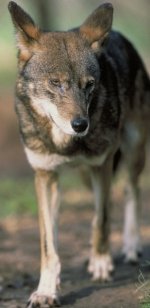 Larger that a coyote, and smaller than a Grey wolf (Canis rufus), the Red wolf thanks its name for its reddish coat in Texan populations of the species. In the last century, persecution, habitat destruction, and hybridization with Coyotes has brought the Red Wolf to the brink of extinction. Only about 270 wolves remain (source). They are shy creatures, often hunting alone or in smaller packs than the Grey wolf. A typical diet consists of rabbits, raccoons and rodents, varied with insects and berries. They are reported to bring down deer with a small pack. By some, the Red wolf is not considered a separate species, but merely a hybrid between a Grey wolf and a coyote. By 1980, the Red Wolf had been completely eliminated from its natural range. Because of the U.S. Fish and Wildlife Service trapping a number of Red Wolves from the wild in the 1970's they could initiate a breeding program on small islands, preventing it’s extinction. Now, it is listed on the U.S. Endangered Species List and classified as endangered in North Carolina and Tennessee.
Larger that a coyote, and smaller than a Grey wolf (Canis rufus), the Red wolf thanks its name for its reddish coat in Texan populations of the species. In the last century, persecution, habitat destruction, and hybridization with Coyotes has brought the Red Wolf to the brink of extinction. Only about 270 wolves remain (source). They are shy creatures, often hunting alone or in smaller packs than the Grey wolf. A typical diet consists of rabbits, raccoons and rodents, varied with insects and berries. They are reported to bring down deer with a small pack. By some, the Red wolf is not considered a separate species, but merely a hybrid between a Grey wolf and a coyote. By 1980, the Red Wolf had been completely eliminated from its natural range. Because of the U.S. Fish and Wildlife Service trapping a number of Red Wolves from the wild in the 1970's they could initiate a breeding program on small islands, preventing it’s extinction. Now, it is listed on the U.S. Endangered Species List and classified as endangered in North Carolina and Tennessee.
The Red wolf is listed as Critically Endangered (CR), facing an extremely high risk of extinction in the wild, on the IUCN Red List of Threatened Species
Namings for the red wolf
A young / baby of a red wolf is called a 'cub, pup or whelp'. The females are called 'bitch or fae' and males 'dog or brute'. A red wolf group is called a 'pack or rout'.Countries
United States
Custom Search